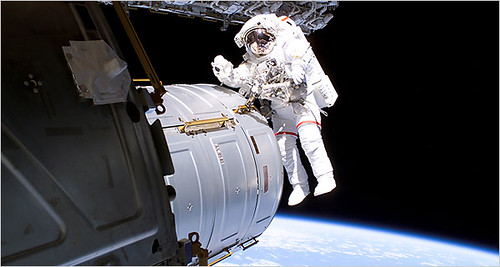Construction to Resume on Space Station

"For more than three years, the International Space Station has floated half-built above the Earth. Maintained by a skeleton crew, the station — an assemblage of modules and girders — has not come close to its stated goal of becoming a world-class research outpost," the New York Times reports.
But the long break in building out the International Space Station— a result of the grounding of the space shuttle fleet following the Columbia disaster— is about to come to an end:
Since the project began in late 1998 with the joining of two American and Russian modules, the United States and 15 other nations have slowly put together a structure that weighs more than 400,000 pounds, with a habitable volume of almost 15,000 cubic feet. When completed, it is to weigh almost a million pounds and have a cabin volume of more than 33,000 cubic feet, larger than a typical five-bedroom house.
Getting to that goal will require some of the most difficult shuttle missions ever mounted by the National Aeronautics and Space Administration, starting with the Atlantis’s launching from the Kennedy Space Center at Cape Canaveral, Fla [next Sunday]. The shuttle and its crew of six will haul a 30,000-pound, 45-foot truss segment to the station, delicately remove it from the cargo bay and install it during three spacewalks by two teams of astronauts….
NASA has allotted about 15 flights to complete the project before the shuttles are retired in 2010. The next four missions will carry other massive truss segments to extend the station’s central girder to more than 350 feet. The girder will eventually support four huge sets of solar-power arrays, batteries and heat-dispensing radiators.
The additional truss segments, which will increase the mass of the station by 40 tons, will also include 10-foot-wide rotary joints shaped like wagon wheels that will allow the solar arrays to track the sun for optimum power as the station moves in orbit. The Atlantis is delivering the second array, joining one put on the station in 2000.
You can learn more about the International Space Station here.
